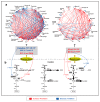Baked Bread Enhances the Immune Response and the Catabolism in the Human Body in Comparison with Steamed Bread
- PMID: 31861252
- PMCID: PMC7019488
- DOI: 10.3390/nu12010001
Baked Bread Enhances the Immune Response and the Catabolism in the Human Body in Comparison with Steamed Bread
Abstract
It is unclear whether different processing methods change the biological functions of foods and how these functions are evaluated in the human body. Here, steamed bread and baked bread, the traditional staple foods in China and many Western countries, were made by steaming and baking, respectively, using one piece of fermented wheat dough and then consumed by 16 healthy young volunteers. By detecting 38 cytokines, 12 metabolic enzymes, glucose, lactate, and nicotinamide adenine dinucleotide (NADH) in the serum, the cytokine network and central metabolic pathway network were investigated to compare the effects of the two staple foods on immunity and metabolism. Compared with steamed bread, baked bread increased (p < 0.05) concentrations of fractalkine and macrophage-derived chemokine, decreased (p < 0.05) the concentration of interleukin-1RA, increased (p < 0.05) the expression level of phosphofructokinase, and decreased (p < 0.05) the expression level of glucose-6-phosphate dehydrogenase in the serum. Two network analyses indicated that baked bread, as compared to the steamed bread, enhanced communication between immune cells, increased catabolism, and decreased anabolism. Further, a correlation analysis of cytokines and metabolic enzymes suggested that the two staple foods may affect metabolism by regulating the secretion of cytokines. These findings highlight how the same raw food material processed by different methods may have different impacts on immunity and metabolism in humans.
Keywords: Baked bread; Cytokine network; Human; Metabolic network; Steamed bread.
Conflict of interest statement
The authors declare no conflict of interest. The funders had no role in the design of the study; in the collection, analyses, or interpretation of data; in the writing of the manuscript, or in the decision to publish the results.
Figures




Similar articles
-
Can bread processing conditions alter glycaemic response?Food Chem. 2015 Apr 15;173:250-6. doi: 10.1016/j.foodchem.2014.10.040. Epub 2014 Oct 19. Food Chem. 2015. PMID: 25466020
-
Comparative study of the nutritional quality of potato-wheat steamed and baked breads made with four potato flour cultivars.Int J Food Sci Nutr. 2017 Mar;68(2):167-178. doi: 10.1080/09637486.2016.1226272. Epub 2016 Sep 9. Int J Food Sci Nutr. 2017. PMID: 27608859
-
Quality characterization of wheat, maize and sorghum steamed breads from Lesotho.J Sci Food Agric. 2014 Aug;94(10):2104-17. doi: 10.1002/jsfa.6531. Epub 2014 Feb 17. J Sci Food Agric. 2014. PMID: 24338919
-
Frozen steamed breads and boiled noodles: Quality affected by ingredients and processing.Food Chem. 2021 Jul 1;349:129178. doi: 10.1016/j.foodchem.2021.129178. Epub 2021 Feb 6. Food Chem. 2021. PMID: 33607545 Review.
-
Par-baked Bread Technology: Formulation and Process Studies to Improve Quality.Crit Rev Food Sci Nutr. 2016;56(1):70-81. doi: 10.1080/10408398.2012.715603. Crit Rev Food Sci Nutr. 2016. PMID: 25000472 Review.
Cited by
-
Cooked Broccoli Alters Cecal Microbiota and Impacts Microbial Metabolism of Glucoraphanin in Lean and Obese Mice.Mol Nutr Food Res. 2025 Mar;69(6):e202400813. doi: 10.1002/mnfr.202400813. Epub 2025 Feb 17. Mol Nutr Food Res. 2025. PMID: 39962804 Free PMC article.
-
Protocol of the PROMOTE study: characterization of the microbiome, the immune response, and one-carbon metabolism in preconceptional and pregnant women with and without obesity (an observational subcohort of the Rotterdam Periconception cohort).PLoS One. 2025 Apr 2;20(4):e0319618. doi: 10.1371/journal.pone.0319618. eCollection 2025. PLoS One. 2025. PMID: 40173397 Free PMC article.
References
-
- Mosca A., Chen J. Food oral management: Physiology and objective assessment. Curr. Opin. Food Sci. 2016;9:11–20. doi: 10.1016/j.cofs.2016.03.003. - DOI
-
- Małgorzata M. Bioactive phenolics of fresh and freeze-dried sweet and semi-spicy pepper fruits (Capsicum annuum, L.) J. Funct. Foods. 2014;7:269–277.
-
- Wang T., He F., Chen G. Improving bioaccessibility and bioavailability of phenolic compounds in cereal grains through processing technologies: A concise review. J. Funct. Foods. 2014;7:101–111. doi: 10.1016/j.jff.2014.01.033. - DOI
Publication types
MeSH terms
Substances
Grants and funding
LinkOut - more resources
Full Text Sources
Research Materials

